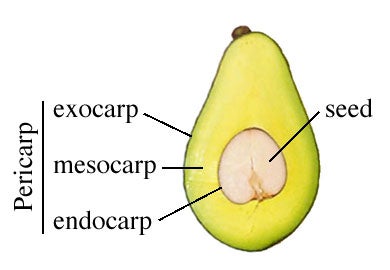Adapted from "What Kind of Fruit is the Avocado?"
By W. B. Storey
Question: What kind of fruit is the avocado?
Answer: A single-seeded berry.
Question: Why a berry?
Answer: For reasons that are discussed below.
A fruit is the matured ovary of a flower. Basically, it consists of the ovary wall, or pericarp, which encloses one or more seeds (see figure right). The pericarp is differentiated into three layers of tissues: the outer layer is exocarp, which commonly is called the skin or rind. The middle layer is mesocarp which, generally,makes up the bulk of the pericarp. The inner layer is endocarp which, in some fruits is tough, leathery or hard, in other fruits is soft or fleshy.
All fruits may be classified into two broad categories: dry, and fleshy. The avocado falls into the latter category.
There are two main classes of fleshy fruits: drupes and berries. Drupes are characterized by having a fleshy mesocarp but a tough-leathery or bony endocarp. They are said to have "stones" or "pits" rather than seeds (example: peaches). Also, a drupe usually has only a single seed. Berries, to the contrary, are characterized by having a fleshy endocarp, as well as mesocarp, and may have more than one seed.
If one examines an avocado fruit cut longitudinally, as above, he sees that the exocarp is the skin or rind. It may be vary thin as in Mexican race avocados or thick and almost woody as in some of the large Guatemalan race fruits. The mesocarp is fleshy and makes up the bulk of the pericarp. The endocarp is thin, often not well differentiated from the mesocarp, and sometimes imperceptible. In some soft ripe avocados, it may adhere to the outer seed coat when the seed coat when the seed is removed from the fruit,giving the seed a sort of frosty appearance.
Now, if we go back to the introductory questions we can see why the answer to what kind of fruit is it? and why is it a berry? is: because it fits all the botanical criteria for that class of fruits.
Source
W. B. Storey. What Kind of Fruit is the Avocado? California Avocado Society Yearbook 1973-74. Pages 70-71.

